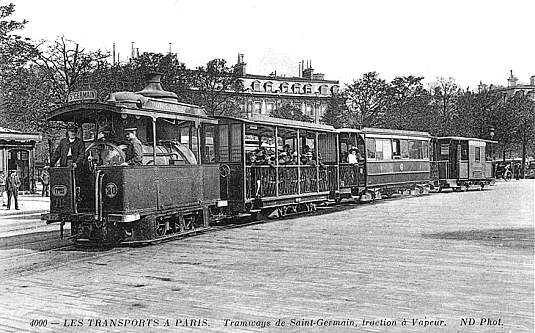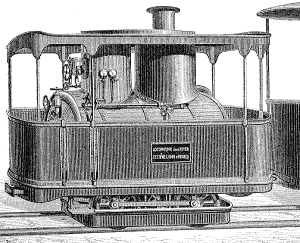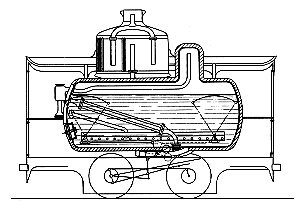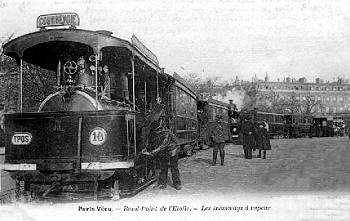

In 1910 Neurdein et Cie of Paris ("N.D.Phot") produced a series of postcards showing transport systems used in Paris. This is card 4000, the first in that series, depicting Lamm & Francq fireless steam tram loco 20 pulling a typical train of trailers on the tramway from Paris to Saint-Germain en Laye. It is standing at the Place de l'Étoile terminus. The small view lower down the page also shows the Étoile terminus around 1910, this time with tram 18. It is from a postcard by L.J & Cie of Angoulême and Paris.
Other postcards from this N.D.Phot series are:
Accumulator Car
Horse Tram
Est-Parisien Electric Tram
CGPT Electric Tram
Purrey Steam Trams (the small views).
Compressed Air Tram (the small view).
 Dr. Emile Lamm, of New Orleans, USA, who in 1870 had designed a tram powered by liquid ammonia, heated by hot water to vaporise the gas within the system, went on to design in 1872 a fireless steam locomotive which he tested pulling trams at Carrollton, then supplying locos to three streetcar rail roads in the New Orleans area, the New Orleans & Carrollton, the New Orleans City and the Crescent City. In 1876 in France, Léon Francq took this design and improved it to produce a prototype for the Rueil to Marly-le-Roi tramway, to the west of Paris, where he was technical director. He also tested fireless steam trams built for him by the Cail company for the tramway in Versailles, where he held the concession to operate trams. However, permission to operate these vehicles in Versailles was not granted so he transferred them to Port-Marly where a full service began on 14th April 1878 using five small tram locos (see drawing left), replacing the horse tramway there which dated from 1855.
Dr. Emile Lamm, of New Orleans, USA, who in 1870 had designed a tram powered by liquid ammonia, heated by hot water to vaporise the gas within the system, went on to design in 1872 a fireless steam locomotive which he tested pulling trams at Carrollton, then supplying locos to three streetcar rail roads in the New Orleans area, the New Orleans & Carrollton, the New Orleans City and the Crescent City. In 1876 in France, Léon Francq took this design and improved it to produce a prototype for the Rueil to Marly-le-Roi tramway, to the west of Paris, where he was technical director. He also tested fireless steam trams built for him by the Cail company for the tramway in Versailles, where he held the concession to operate trams. However, permission to operate these vehicles in Versailles was not granted so he transferred them to Port-Marly where a full service began on 14th April 1878 using five small tram locos (see drawing left), replacing the horse tramway there which dated from 1855.
 The tramway to Saint Germain was an extension to the Rueil to Marly-le-Roi line. The Compagnie du Tramway à vapeur de Paris à Saint-Germain (PSG) took over this tramway and continued the line east to Courbevoie and west to Saint-Germain en Laye. From Courbevoie the tramway used the tracks of the Compagnie des Tramways Nord to reach Place de l'Étoile. The route of about 18 km fully opened on 16th May 1890. As well as the depot at Port-Marly, an additional one was built at Courbevoie, both of which had steam generators to charge the trams. In 1890, PSG had nine larger and more powerful engines of a Lamm and Francq design built for them by Fives Lille (see drawing right). The Tramways Nord used horse traction on their route, which slowed down the service and so in 1889 they had Cail convert fourteen earlier steam trams to the Lamm & Francq design. Lamm & Francq fireless trams also ran in Lille from 1878, Lyon from 1888 and Marseille from 1893.
The tramway to Saint Germain was an extension to the Rueil to Marly-le-Roi line. The Compagnie du Tramway à vapeur de Paris à Saint-Germain (PSG) took over this tramway and continued the line east to Courbevoie and west to Saint-Germain en Laye. From Courbevoie the tramway used the tracks of the Compagnie des Tramways Nord to reach Place de l'Étoile. The route of about 18 km fully opened on 16th May 1890. As well as the depot at Port-Marly, an additional one was built at Courbevoie, both of which had steam generators to charge the trams. In 1890, PSG had nine larger and more powerful engines of a Lamm and Francq design built for them by Fives Lille (see drawing right). The Tramways Nord used horse traction on their route, which slowed down the service and so in 1889 they had Cail convert fourteen earlier steam trams to the Lamm & Francq design. Lamm & Francq fireless trams also ran in Lille from 1878, Lyon from 1888 and Marseille from 1893.
Although the use of fireless steam locos on tramways was rare, they were used for many years in locations where the fire or sparking was dangerous or cleanliness was required, such as in the chemical and paper industries, in food production and in mines, particularly at locations where steam was already available. These locos were still being produced in the 1960s and many have been preserved. The principle that these designs use is that water boils at a much higher temperature at higher pressure. A reservoir takes the place of the boiler on a normal steam engine. This is about three quarters filled with water. Superheated steam from a fixed charging point is then passed in, which raises both water temperature and pressure. When the regulator is opened steam passes to the cylinders as in a normal loco. The pressure in the reservoir drops which lowers the boiling point of the water, causing it to boil and create more steam. In this way steam produced safely elsewhere can be stored and used in the locomotive.
For the Lamm & Francq trams the initial water temperature was 198°C at a pressure of 15kg/cm² (213psi). The steam passed through a pressure reducing valve to give a working pressure of about 7kg/cm² (100psi), which was further controlled by the regulator to give a cylinder pressure of 3 to 7kg/cm² (43 to 100psi). It took about 7 minutes to charge the engine which would then run for about 15km, after which the pressure would have dropped to 3.5kg/cm² (50psi) and water temperature to 140°C.
 The original Lamm & Francq tram locos from Cail as on the postcards were 3.47 metres long and 2.07 metres wide. There were controls at both ends. In service they weighed 8.7 tons. They were 0-4-0 with a 1.3 metre wheelbase and 75 cm diameter wheels. They had two pistons of 23 cm bore and 25 cm stroke and used Stephenson's link motion. Air cooled condensers with vertical tubes were fitted up to the roof level. There was a one metre diameter, two metre long cylindrical reservoir made of 14mm thick steel plate with a volume of 2.83 cubic metres containing 1,900 litres of water. This reservoir was thermally insulated with a 35 mm thick layer of wood and cork. Steam from the static charge point passed into the water in the reservoir through a perforated pipe at its base, the significant feature of the Lamm & Francq design. The tram locos were fitted with a large dome above the reservoir to collect the steam. Tram 18 was former PSG tram 4 of 1877, whereas tram 20 had been tram 6, an additional loco to a similar design built in 1886
The original Lamm & Francq tram locos from Cail as on the postcards were 3.47 metres long and 2.07 metres wide. There were controls at both ends. In service they weighed 8.7 tons. They were 0-4-0 with a 1.3 metre wheelbase and 75 cm diameter wheels. They had two pistons of 23 cm bore and 25 cm stroke and used Stephenson's link motion. Air cooled condensers with vertical tubes were fitted up to the roof level. There was a one metre diameter, two metre long cylindrical reservoir made of 14mm thick steel plate with a volume of 2.83 cubic metres containing 1,900 litres of water. This reservoir was thermally insulated with a 35 mm thick layer of wood and cork. Steam from the static charge point passed into the water in the reservoir through a perforated pipe at its base, the significant feature of the Lamm & Francq design. The tram locos were fitted with a large dome above the reservoir to collect the steam. Tram 18 was former PSG tram 4 of 1877, whereas tram 20 had been tram 6, an additional loco to a similar design built in 1886
In 1891 PSG gave up fireless operation and introduced conventional Blanc-Misseron steam trams on the route from Courbevoie towards Saint-Germain due to requiring more power to deal with increased loads and longer trains, but they sold the original small Lamm & Francq fireless locos to the Compagnie des Tramways de Paris et du Département de la Seine (TPDS) for continued operation of the section from Courbevoie to Étoile. The nine more powerful locos were also sold, five joined the non-connected line from Saint-Germain to Poissey and the other four went to Lyon. In 1894, TPDS took over the, by then, bankrupt Tramways Nord and in 1910 absorbed the PSG. TPDS renumbered the original Lamm & Francq locos in the range 15 to 20 in their fleet and it is in this guise that they are seen on our postcard views in 1910. Most having run 34 years, they were finally withdrawn when the line was electrified on 20th May 1911, electric trams lasting until 21st January 1935. Lamm & Francq locos were also used in Lyon and Marseille for a few years at the end of the nineteenth century.
![]() Go to Postcard Of The Month Index
Go to Postcard Of The Month Index